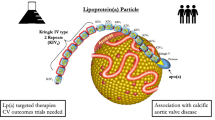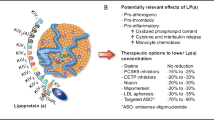Opinion statement
Currently, there are significant data to support a link between lipoprotein(a) [Lp(a)] levels and cardiovascular risk. However, there has not been a clinical trial examining the effects of Lp(a) reduction on cardiovascular risk in a primary prevention population. Until such a trial is conducted, current consensus supports using an Lp(a) percentile greater than 75% for race and gender as a risk stratification tool to target more aggressive low-density lipoprotein cholesterol (LDL-C) or apolipoprotein B (apoB) goals. Therefore, Lp(a) measurements should be considered in the following patients: individuals with early-onset vascular disease determined by clinical presentation or subclinical imaging, intermediate and high Framingham risk patients with a family history of premature coronary disease, and low Framingham risk patients with a family history and low high-density lipoprotein cholesterol (HDL-C) levels. Once LDL-C goals are met, Lp(a) levels may be taken into account in selecting secondary agents to reach more aggressive secondary goals, including non-HDL-C and apoB. To achieve Lp(a) reduction, one evidence-based approach is to initiate therapy with low-dose aspirin and extended-release niacin, titrated from 0.5 g up to 2 g over several weeks. If higher doses of niacin are desired, crystalline niacin allows for titration to a dosage as high as 2 g three times a day; however, the flushing side effect usually is quite prominent. Although hormone replacement therapy (HRT) has been shown to lower Lp(a), there are no indications for using HRT for primary or secondary prevention; therefore, we do not advocate initiating it solely for Lp(a) reduction. LDL apheresis is an option to lower LDL-C levels in patients with homozygous familial hypercholesterolemia who are not responsive to medical therapy. Although it does lower Lp(a), there is no treatment indication for this. A recent study supports the cholesterol absorption inhibitor ezetimibe’s ability to lower Lp(a), a finding that deserves further investigation as it has not been previously reported in multiple ezetimibe trials. Additionally, the apoB messenger RNA antisense therapy mipomersen currently is in phase 3 trials and may serve as a potential inhibitor of Lp(a) production. Ultimately, more trial evidence is needed to determine whether lowering Lp(a) actually reduces cardiovascular risk, although this may be difficult to isolate without a specific Lp(a)-lowering therapy.

Similar content being viewed by others
References and Recommended Reading
Papers of particular interest, published recently, have been highlighted as: • Of importance •• Of major importance
Cannon CP, Braunwald E, McCabe CH, et al.: Intensive versus moderate lipid lowering with statins after acute coronary syndromes. N Engl J Med 2004, 350(15):1495–1504.
Erqou S, Kaptoge S, Perry PL, et al.: Lipoprotein(a) concentration and the risk of coronary heart disease, stroke, and nonvascular mortality. JAMA 2009, 302(4):412–423.
Hancock MA, Boffa MB, Marcovina SM, et al.: Inhibition of plasminogen activation by lipoprotein(a): critical domains in apolipoprotein(a) and mechanism of inhibition on fibrin and degraded fibrin surfaces. J Biol Chem 2003, 278(26):23260–23269.
van der Hoek YY, Wittekoek ME, Beisiegel U, et al.: The apolipoprotein(a) kringle IV repeats which differ from the major repeat kringle are present in variably-sized isoforms. Hum Mol Genet 1993, 2(4):361–366.
Clarke R, Peden JF, Hopewell JC, et al.: Genetic variants associated with Lp(a) lipoprotein level and coronary disease. N Engl J Med 2009, 361(26):2518–2528.
Brunner C, Lobentanz EM, Petho-Schramm A, et al.: The number of identical kringle IV repeats in apolipoprotein(a) affects its processing and secretion by HepG2 cells. J Biol Chem 1996, 271(50):32403–32410.
Kraft HG, Lingenhel A, Pang RW, et al.: Frequency distributions of apolipoprotein(a) kringle IV repeat alleles and their effects on lipoprotein(a) levels in Caucasian, Asian, and African populations: the distribution of null alleles is non-random. Eur J Hum Genet 1996, 4(2):74–87.
Geethanjali FS, Luthra K, Lingenhel A, et al.: Analysis of the apo(a) size polymorphism in Asian Indian populations: association with Lp(a) concentration and coronary heart disease. Atherosclerosis 2003, 169(1):121–130.
Marcovina SM, Albers JJ, Wijsman E, et al.: Differences in Lp[a] concentrations and apo[a] polymorphs between black and white Americans. J Lipid Res 1996, 37(12):2569–2585.
Marcovina SM, Koschinsky ML: Lipoprotein(a): structure, measurement, and clinical significance. In Handbook of Lipoprotein Testing, edn 2nd. By Rifai N, Warnick GR, Dominiczak MH. Washington: AACC Press; 2000:345–368.
Shlipak MG, Simon JA, Vittinghoff E, et al.: Estrogen and progestin, lipoprotein(a), and the risk of recurrent coronary heart disease events after menopause. JAMA 2000, 283(14):1845–1852.
Espeland MA, Marcovina SM, Miller V, et al.: Effect of postmenopausal hormone therapy on lipoprotein(a) concentration. PEPI Investigators. Postmenopausal Estrogen/Progestin Interventions. Circulation 1998, 97(10):979–986.
Marcovina SM, Koschinsky ML, Albers JJ, Skarlatos S: Report of the National Heart, Lung, and Blood Institute Workshop on Lipoprotein(a) and Cardiovascular Disease: recent advances and future directions. Clin Chem 2003, 49(11):1785–1796.
Sattar H, Christian K, Harmon MP, et al.: High-resolution cardiovascular magnetic resonance imaging of the carotid arteries reliably detects very significant early atherosclerosis in patients with elevated Lp(a). J Cardiovasc Magn Res 2007, 9:335–336.
Shin MJ, Blanche PJ, Rawlings RS, et al.: Increased plasma concentrations of lipoprotein(a) during a low-fat, high-carbohydrate diet are associated with increased plasma concentrations of apolipoprotein C-III bound to apolipoprotein B-containing lipoproteins. Am J Clin Nutr 2007, 85(6):1527–1532.
Bloedon LT, Balikai S, Chittams J, et al.: Flaxseed and cardiovascular risk factors: results from a double blind, randomized, controlled clinical trial. J Am Coll Nutr 2008, 27(1):65–74.
Mora S, Lee IM, Buring JE, Ridker PM: Association of physical activity and body mass index with novel and traditional cardiovascular biomarkers in women. JAMA 2006, 295(12):1412–1419.
Guyton JR, Blazing MA, Hagar J, et al.: Extended-release niacin vs gemfibrozil for the treatment of low levels of high-density lipoprotein cholesterol. Niaspan-Gemfibrozil Study Group. Arch Intern Med 2000, 160(8):1177–1184.
Linke A, Sonnabend M, Fasshauer M, et al.: Effects of extended-release niacin on lipid profile and adipocyte biology in patients with impaired glucose tolerance. Atherosclerosis 2009, 205(1):207–213.
Maccubbin D, Bays HE, Olsson AG, et al.: Lipid-modifying efficacy and tolerability of extended-release niacin/laropiprant in patients with primary hypercholesterolaemia or mixed dyslipidaemia. Int J Clin Pract 2008, 62(12):1959–1970.
Airan-Javia SL, Wolf RL, Wolfe ML, et al.: Atheroprotective lipoprotein effects of a niacin-simvastatin combination compared to low- and high-dose simvastatin monotherapy. Am Heart J 2009, 157(4):687–688.
Ballantyne CM, Davidson MH, McKenney J, et al.: Comparison of the safety and efficacy of a combination tablet of niacin extended release and simvastatin vs simvastatin monotherapy in patients with increased non-HDL cholesterol (from the SEACOAST I study). Am J Cardiol 2008, 101(10):1428–1436.
McKenney JM, Jones PH, Bays HE, et al.: Comparative effects on lipid levels of combination therapy with a statin and extended-release niacin or ezetimibe versus a statin alone (the COMPELL study). Atherosclerosis 2007, 192(2):432–437.
Sharma M, Sharma DR, Singh V, et al.: Evaluation of efficacy and safety of fixed dose lovastatin and niacin(ER) combination in Asian Indian dyslipidemic patients: a multicentric study. Vasc Health Risk Manag 2006, 2(1):87–93.
Scanu AM, Bamba R: Niacin and lipoprotein(a): facts, uncertainties, and clinical considerations. Am J Cardiol 2008, 101(8A):44B–47B.
Nozue T, Michishita I, Mizuguchi I: Effects of ezetimibe on remnant-like particle cholesterol, lipoprotein (a), and oxidized low-density lipoprotein in patients with dyslipidemia. J Atheroscler Thromb 2010, 17(1):37–44.
Morgan JM, Capuzzi DM, Guyton JR: A new extended-release niacin (Niaspan): efficacy, tolerability, and safety in hypercholesterolemic patients. Am J Cardiol 1998, 82A(12):29U–34U.
Taylor AJ, Villines TC, Stanek EJ, et al.: Extended-release niacin or ezetimibe and carotid intima-media thickness. N Engl J Med 2009, 361(22):2113–2122.
Lai E, De Lepeleire I, Crumley TM, et al.: Suppression of niacin-induced vasodilation with an antagonist to prostaglandin D2 receptor subtype 1. Clin Pharmacol Ther 2007, 81(6):849–857.
Maher VM, Brown BG, Marcovina SM, et al.: Effects of lowering elevated LDL cholesterol on the cardiovascular risk of lipoprotein(a). JAMA 1995, 274(22):1771–1774.
Suk DJ, Rifai N, Buring JE, Ridker PM: Lipoprotein(a), hormone replacement therapy, and risk of future cardiovascular events. J Am Coll Cardiol 2008, 52(2):124–131.
Manning PJ, Allum A, Jones S, et al.: The effect of hormone replacement therapy on cardiovascular risk factors in type 2 diabetes: a randomized controlled trial. Arch Intern Med 2001, 161(14):1772–1776.
Insull Jr W, Davidson MH, Kulkarni PM, et al.: Effects of raloxifene and low-dose simvastatin coadministration on plasma lipids in postmenopausal women with primary hypercholesterolemia. Metabolism 2005, 54(7):939–946.
Walsh BW, Kuller LH, Wild RA, et al.: Effects of raloxifene on serum lipids and coagulation factors in healthy postmenopausal women. JAMA 1998, 279(18):1445–1451.
Varga EA, Moll S: Cardiology patient pages. Prothrombin 20210 mutation (factor II mutation). Circulation 2004, 110(3):e15–e18.
Herrington DM, Vittinghoff E, Howard TD, et al.: Factor V Leiden, hormone replacement therapy, and risk of venous thromboembolic events in women with coronary disease. Arterioscler Thromb Vasc Biol 2002, 22(6):1012–1017.
Toh S, Hernandez-Diaz S, Logan R, et al.: Coronary heart disease in postmenopausal recipients of estrogen plus progestin therapy: does the increased risk ever disappear? A randomized trial. Ann Intern Med 2010, 152(4):211–217.
Kagawa A, Azuma H, Akaike M, et al.: Aspirin reduces apolipoprotein(a) (apo(a)) production in human hepatocytes by suppression of apo(a) gene transcription. J Biol Chem 1999, 274(48):34111–34115.
Akaike M, Azuma H, Kagawa A, et al.: Effect of aspirin treatment on serum concentrations of lipoprotein(a) in patients with atherosclerotic diseases. Clin Chem 2002, 48(9):1454–1459.
Chasman DI, Shiffman D, Zee RY, et al.: Polymorphism in the apolipoprotein(a) gene, plasma lipoprotein(a), cardiovascular disease, and low-dose aspirin therapy. Atherosclerosis 2009, 203(2):371–376.
Stefanutti C, D’Alessandri G, Russi G, et al.: Treatment of symptomatic HyperLp(a)lipoproteinemia with LDL-apheresis: a multicentre study. Atheroscler Suppl 2009, 10(5):89–94.
Merki E, Graham MJ, Mullick AE, et al.: Antisense oligonucleotide directed to human apolipoprotein B-100 reduces lipoprotein(a) levels and oxidized phospholipids on human apolipoprotein B-100 particles in lipoprotein(a) transgenic mice. Circulation 2008, 118(7):743–753.
Disclosure
Dr. Voros has received research grant support from Merck and Abbott Pharmaceuticals. No other potential conflicts of interest relevant to this article were reported.
Author information
Authors and Affiliations
Corresponding author
Rights and permissions
About this article
Cite this article
Joshi, P.H., Krivitsky, E., Qian, Z. et al. Do We Know When and How to Lower Lipoprotein(a)?. Curr Treat Options Cardio Med 12, 396–407 (2010). https://doi.org/10.1007/s11936-010-0077-6
Published:
Issue Date:
DOI: https://doi.org/10.1007/s11936-010-0077-6




